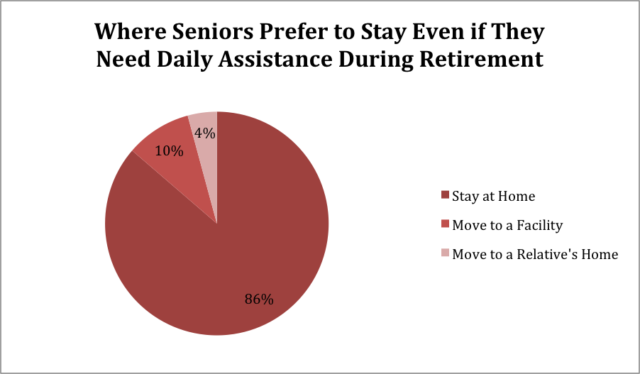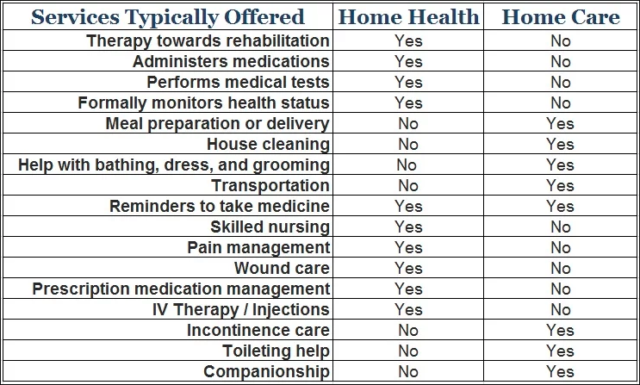Americans 65 and above will require some form of long-term care according to ALTCP ltc statistics. These people who are 65 and above is projected to balloon from 46 million today to over 98 million by 2060. This report by the Population Reference Bureau (PRB) in the U.S demographic shift gives us a peak of what lies ahead – the massive demand for in home care and other types of long-term care services.
Among the long-term care services available today, home care is the most appealing among the aging population because in home care costs are usually lesser than a nursing home and assisted living costs.

What is In Home Care?
In home care is defined as a type of care that is unskilled or non-clinical provided by family members or friends who assume the role of caregiver or paid home care aides trained to help older adults carry out their Activities of Daily Living (ADLs).
Different Types of Home Care Services
Here is a list of home care services available to older adults today.
- Family Caregiving – this is the type of care given at home by family members and friends. Care recipients choose this care type because they don’t have funds to pay for a professional caregiver or they prefer to keep the caregiving personal.
- Home Health Care – a type of clinical care provided by a registered nurse, physical therapist, occupational therapist or other skilled medical professionals, which is often prescribed after hospitalization. Some of the home care services are as follows: prescription management, at-home physical therapy, caring for wounds and others.
- Homemaker Services – the type of care given to aging individuals who can no longer carry out their day-to-day household duties.
- Home Telehealth – a variety of technological devices the help deliver virtual, medical, health and education services.
How Can I Pay for In-Home Care Services?
There are different ways to pay for in home care costs and to help you narrow choices, here are the best payment options for in home care services
Long-Term Care Insurance
Long-term care insurance is defined as a product designed to pay for different types of long-term care in different care settings. This type of insurance can be personalized based on the policyholder’s long-term care needs and preferences.
The best time to buy insurance for long-term care is when they are in their 50s to enjoy lower premiums and to have peace of mind early knowing that they have a policy that would cover their ltc expenses.
Government Programs
Medicare
Medicare is a federal-state insurance that covers 100-day maximum stay in a nursing home for rehabilitation care. It also pays for home health care services as long as a physician prescribes it.
You need to be 65 and older, anyone younger than 65 who has certain disabilities and those with late-stage kidney failure are eligible for Medicare benefits.
Medicaid
Medicaid is a pays for long-term care but individuals must be below a certain income level defined by the state they reside in before they can qualify.
Self-insuring
Self-insuring means paying for in home care costs out-of-the-pocket. It’s a good option for individuals who only need short-term coverage because self-insuring for an extended period of time might deplete your savings.
Read Next: Long Term Care Insurance vs Self-Insuring: What Is Best for You?
How Can I Save On In Home Care Costs?
Families can save a significant amount on in home senior care cost by exploring the following options:
1. Independent Caregivers or Home Care Agencies
Independent caregivers are more affordable compared to hiring caregivers through home care agencies. Hiring independent caregivers can save you around 20%-30% than hiring through an agency.
However, there are pros and cons to hiring independent caregivers. You need to screen potential caregivers and do background checks to make sure that they can be trusted and can provide quality care. Unlike in agencies, they perform background checks on their employees, provide home care aide substitutes on short notice and can give you the security you need.
2. Hire Home Care Aides Instead of Home Health Aides
It’s important to determine first the needs of the aging individual whether he or she would need a home care aide or a home health care aide. Find out whether a home care aide or homemaker services would suffice since it is usually 10%-15% less expensive than home health aides.

Compare the average daily cost of home care aides and home health aides below.
Average Daily Cost of Home Care Services | |
| Homemaker Services | $135 |
| Home Health Aide | $139 |
You can view the average monthly and annual cost of home care services here.
Check out our infographic on Top 10 U.S States with Cheapest In-Home Care Services.
3. Use Tax Deductions and Credits
You can use long-term care tax deductions to reduce the cost of in home services. An aging individual can also receive additional tax credits if he or she is dependent on someone’s tax return.
4. Home Modifications
Receiving care at home is appealing among the graying population because it is familiar and provides utmost comfort. Instead of moving to a nursing home or assisted living facility, many older adults prefer home care.
But is it really safe to age in place?
Through home modifications, it’s possible to turn a home into a sanctuary safe for seniors. Here are some basic home modifications that can make in-home care safe and more affordable.
- Remove things that are trip hazard.
- Make the rooms more spacious.
- Move items within your reach.
- Consider adding more lights.
- Install grab bars.
- Install smoke detector with lights and doorbell.
- Install a walk-in tub.
- Install wheelchair ramps.
- Add a stair lift.
- Add traction slips inside the bathroom.
5. Use New Technologies
Instead of hiring caregivers, take advantage of new technologies that can make in home care safe and provide quality care.
Seniors can now wear monitoring systems that can help prevent falls, track their movements, heart rate, and other useful data, which can help family members track signs of decline in their health and they can make the necessary intervention right away.
Other new technologies include home security systems like motion detectors that track movements around the house and send alerts to family members in case the sensors haven’t tracked any movement inside the house for a few days, and they will be alerted to check on their aging loved ones.
Since aging individuals often forget to take medications, a medication reminder can help them take the right dosage at the right time.
6. Meal Delivery Service
Most aging individuals need assistance in preparing their meals. Instead of hiring someone to do it for them, they can just subscribe to meal delivery services like Meals on Wheels, which may cost less compared to preparing their own meals or purchasing frozen meals.
